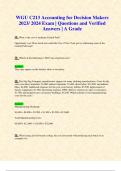WGU C 213 Accounting for Decision Makers 2023/ 2024 Exam | Questions and Verified Answers | A Grade Q: What is the cost to maintain Central Park? Opportunity cost: How much rent could the City of New York get by subleasing some of the Central Park land? Q: Which of the following is NOT true of period costs? Answer: They may appear on the balance sheet as inventory. Q: The Zig -Zag Company manufactures zippers for many clothing manufacturers. Costs for the year were direct materials, $5,000; indirect materials, $1,600; direct labor, $12,000; and indirect labor, $4,000. Additional expenses for the year were factory utiliti es $3,500; depreciation of factory equipment, $1,300; advertising expense, $900; delivery expense on sales to customers, $1,700; and property taxes on factory buildings, $5,200. Which amount is total manufacturing costs for the year? Answer: Manufacturing Overhead: $1,600 + $4,000 + $3,500 + $1,300 + $5,200 = $15,600 Total Manufacturing Costs: $5,000 + $12,000 + $15,600 = $32,600 Q: When using activity -based costing, the cost associated with producing each batch is an example of a: Answer: Cost pool Q: Tracing overhead costs to activities involves dividing overhead costs into: Answer: Cost pools Q: If activity -based costing is used, property taxes would be classified as a: Answer: Facility Support Activity Q: For greater accuracy when using activity -based costing, management accountants should: Answer: Have a larger number of cost pools Q: 5 Steps in ABC Answer: 1. Identify overhead cost activities in each process (Unit, Batch, Product Line, & Facility Support) for an example electricity, 2. Analyze individual overhead costs in terms of cost activities (cost pools: how much OC is created by Unit, Batch, Product Line, & Facility = the end results, 3. Identify measurable cost drivers (we need cost drivers which is a numerical measure that reflects the amount of an overhead cost caused by a particular activity). Each overhead cost activities need a cost driver. 4. Assign overhead ( 5. Use the ABC data to make decisions ( Q: Overhead cost associated with Unit (production process) Cost drivers Answer: . Normal wear -and-tear on machines . Electricity . Routine cleanup . Routine maintenance . Regular accounting Q: Overhead cost with Batches (cost drivers) More batches = More overhead Answer: . Machine cleaning . Machine setup, machine wear -and-tear . Supervisor and inspector involvement . Accounting reports Q: Overhead cost with Product Line (cost drivers) Answer: . Product involvement . Supervisor and inspector time . Accounting reports Q: An activity that affects a particular cost is a(n): Answer: Cost driver Q: Overhead cost with Facility Support (No cost drivers) Answer: . Property taxes . Security guards . Routine regulatory reports These OC do NOT increase regulars of production. It would not make sense to assign any of these cost to the production. Q: When assigning cost drivers to facility support activities, an appropriate cost driver would be: Answer: No cost driver should be assigned Q: Company A allocates one type of overhead cost on the basis of movement of materials. The number of movement of materials processed is an example of a(n): Answer: Cost driver Q: The traditional overhead cost allocation system assumes a simple relationship between overall overhead cost and Answer: A single measure of activity Q: A more accurate allocation of manufacturing overhead and product costing can take place when costs are assigned on the basis of: Answer: Cost drivers




